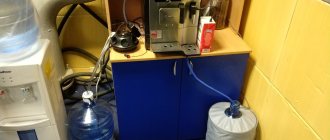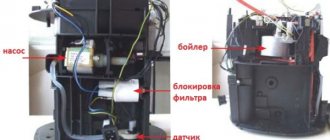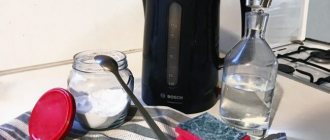For centuries, there was practically the only way to make coffee - in a Turk or cezve. Now modern devices have come to the rescue - a coffee maker, a French press, a coffee machine. The latest invention is the pinnacle of technical progress; it allows you to grind coffee beans, brew all kinds of drinks with milk and cream, and whip them. But sooner or later the owner faces a problem - descaling the coffee machine.
What is decalcification of a coffee machine
Hard water contains large amounts of calcium salts. They form a loose film on the walls of the coffee machine, which attaches to itself the salts of other metals contained in the water. Decalcification is the process of removing salt deposits.
Mechanical descaling using cleaning pastes containing abrasive particles causes serious damage to the elements of the coffee machine and can lead to serious damage. Therefore, to decalcify and clean coffee machines from coffee oils, special compositions are used that contain substances that soften and remove the scale layer.
Coffee beans contain vegetable oil, which turns into liquid form when heated .
After cooling, drops of oil become thicker and accumulate on the internal elements of the coffee machine. Over time, like any other oil, it becomes rancid, giving the coffee an unpleasant taste.
Methods and products for cleaning a coffee machine
Decalcification
Using special cleaning products, the coffee machine device is decalcified. To do this, you should clean the device once or twice a year with decalcifying pills. They completely remove even the smallest deposits.
The most ideal option is to purchase a product for a coffee machine of a certain brand: Saeco, DeLonghi, Bosch, Krups. Produced from manufacturers, they are more expensive than regular ones from hardware stores, but they are more effective.
Can be used for decalcification:
- Cleansing pills,
- Aqueous products
- Citric acid.
How scale appears
Any drinking water, even bottled or filtered, contains a certain amount of dissolved salts, mainly calcium, magnesium, and iron compounds.
When water is heated to a boil, some of the salts precipitate , which accumulates on the walls of the coffee machine, forming scale, which leads to wear of parts and breakdown of the device. Over time, this layer becomes thicker and denser. The rate of formation of the limescale layer depends on the concentration of salt in the water.
The harder the water, the more often you will have to clean the coffee machine to remove scale.
Descaling products
Chemical
They contain acid-containing components. They can only be used for units with steel, glass or plastic coating. The substances are effective, but the acid negatively affects the automation system and corrodes rubber seals.
Removal of solid deposits is carried out in a room that is ventilated or in which there is a powerful exhaust hood. The fight against scale is not only measures to eliminate plaque, but also the prevention of its occurrence.
Softening filters
Effective products that significantly reduce water hardness. Prevents the appearance of plaque. After application, calcium and magnesium ions precipitate and do not reach the surface of the heating components.
Technological method of protection
This cleaning option was developed by household appliance manufacturers. The effectiveness of the method in protecting the device from solid deposits and saving electricity.
The Delonghi company (Italy) produced a natural-based product called Optimal.
The key characteristics of the substance include:
- Effectively cleans multiple layers.
- In addition to cleaning coffee machines and components, the product removes solid accumulations in teapots.
- Lactic acid is taken as the base.
- The 500 ml size is enough for 5 cleanings.
- The product has been tested and is safe for use.
When cleaning the coffee machine, you must follow the recommendations:
- Do not allow product to come into contact with acid-sensitive surfaces. For example, when the coffee machine is installed on a marble surface, it is important to place a film over it before cleaning.
- Read the instructions for using the product.
- The substance should not come into contact with the skin or organs of vision. In case of contact, wash immediately with cold water.
- Keep out of the reach of children.
Advantages and disadvantages:
- High efficiency . Many enterprises purchase industrial anti-scale products at wholesale prices. Purchasing large quantities is economically beneficial. Substances that have been developed specifically for the destruction of lime deposits really help in solving many difficulties.
- Safe influence . Many modern products do not have a negative effect on aluminum and copper parts. They contain substances adapted for processing zinc-coated steel.
- Wide scope of application . The products are used to clean heat exchangers, condensers, boilers, radiators, heating systems, pumping and other equipment. They are used at energy enterprises, in boiler houses, etc. They are also suitable for home use.
How to descale a coffee machine with citric acid
Manufacturers offer a variety of descalers, but they are all quite expensive, and limescale must be removed every month. Large companies such as DeLonghi, Philips, Bosh produce branded cleaning products for their household appliances. You can find universal cleaners on sale, both liquid and tablets.
You cannot use descaling compounds designed to remove deposits from the surface of gas stoves or sinks; this will lead to damage to the machine. The main active ingredient in most branded products is citric acid. Many coffee machine owners have been cleaning their equipment themselves for years using a citric acid solution without causing harm to their equipment.
Citric acid has a number of undoubted advantages:
- safety for human health and the environment;
- efficiency, it removes even old scale;
- no toxic fumes when heated;
- accessibility, it is in any home;
- low price.
All this explains the popularity of citric acid as a cleaning agent for household appliances.
The main cleaning steps are the same as when using a store-bought product:
- filling the reservoir with cleaning solution;
- cleaning process;
- removal of cleaning solution;
- thorough washing.
Let's take a closer look at how to clean a coffee machine using home remedies; the instructions for servicing household appliances will help us with this.
Descaling
The main stages of descaling are the same for different types of coffee machines. It is necessary to strictly adhere to the instructions, only instead of using a special product, use citric acid, having previously diluted it in water.
If you haven’t cleaned your coffee machine for a long time and a solid layer of scale has formed, dissolve 50-100 g of citric acid in one liter of water. If you care for your household appliance regularly, a 30% solution is sufficient (proportions: 30 g of acid per 1 liter of water).
Sequencing:
- Prepare a solution, stir until the acid is completely dissolved.
- Fill the reservoir up to the mark indicating the maximum amount of liquid possible.
- Insert the container with the solution into the coffee machine and carry out the cleaning procedure, following the instructions. If your equipment does not have an automatic cleaning function, pour in the solution, wait a quarter of an hour, turn on the device by selecting the “coffee preparation” function.
- Turn off, remove the reservoir, pour out the remaining solution, rinse.
Almost all modern models have a scale formation indicator ; if you do not have such a function, descale the coffee machine with citric acid every 1-2 months, depending on the frequency of use of the household appliance and the hardness of the water.
First rinse cycle
To prevent residual citric acid from spoiling the taste of coffee, the coffee machine must be rinsed thoroughly:
Fill the tank with clean water to the maximum level, install it in the machine, select the “coffee preparation” function without adding coffee powder. The first rinse will take you 3-5 minutes.
Second rinse cycle
To completely get rid of citric acid, rinse the tank thoroughly, fill it with clean water, and repeat the “coffee preparation” mode without adding coffee itself. This completes the procedure for cleaning the coffee machine with citric acid, and the scale has been removed.
How to determine if an appliance needs cleaning
The main sign that the device needs cleaning is the appearance of scale, which gets into the finished drink and spoils the taste. Residues of coffee oil, scale and unwashed milk particles in the cappuccino maker are an excellent place for the growth of pathogenic bacteria.
The appearance of sediment in the cup is a reason for scheduled cleaning. In addition, you should be wary of bitterness in the drink, a thin stream when serving the finished drink, too loud operation and extraneous sounds when the machine is operating. Another sure sign is that the coffee takes longer to prepare.
In addition, many modern models of coffee machines are equipped with a sensor that shows the level of contamination. If this indicator turns on, it’s time to completely clean the device.
If the system has a self-cleaning option, fill the reservoir with water, add cleaning agent, start the process and follow the instructions that appear on the display. As a rule, this is a request to add water or re-clean a block.
Machines without self-cleaning require a different algorithm:
- clean filters and trays manually;
- Pour the cleaning agent into a suitable container with water;
- if you have a cappuccino maker, place a container under it for draining;
- start cleaning, add cleaning agent gradually;
- rinse all parts thoroughly under running water;
- Brew a couple of test portions of coffee, then pour them out.
When solving the problem of how to wash a coffee machine, you must first carefully study the instructions for the device you are using.
It is recommended to use test strips to measure the hardness of the water used and enter the data into the device.
There are several general rules for cleaning coffee systems, regardless of model.
General cleaning rules:
- Dissolve tablets and powders in water before use; mix liquid products with water; for capsule systems, use special capsules for cleaning.
- Remove the filter from the tank so as not to damage it with cleaning compounds.
- Use not only branded cleaners, but also alternative ones.
- After every 300-400 cups prepared, perform a complete cleaning, removing all parts of the device.
In addition to internal cleaning of the system, the external elements of the device also need care:
- Infuser – remove any remaining ground coffee with a sponge and warm water.
- Cappuccino maker - press the hot water release button, the water will wash away the milk residues. If the cappuccino maker is removable, it is better to remove it and rinse it under hot water.
- Holder (horn in a coffee machine) - wash in running water with a cleaning agent, after opening the horn with a screwdriver.
How to descale a coffee maker with vinegar
Vinegar is a natural cleaning agent that removes limescale and grease residue well; it is often used to descale coffee machines at home, along with citric acid.
Cleaning method:
- Prepare a cleaning solution: add 2 parts water to 1 part vinegar.
- Pour the solution into the water container, insert it into the coffee machine, and turn on the cleaning mode. If there is no such mode, select the “coffee preparation” function.
- After turning off the household appliance, wait 15–20 minutes for the scale to dissolve better
- Rinse the tank, fill with clean water, and bring to a boil as you would brew coffee. Drain the water and repeat the procedure.
When heating, vinegar vapors are very unpleasant for humans; open a window for ventilation.
Automatic cleaning and washing of device parts
How to clean a machine that has the Auto Clean function built-in? Each coffee brewing unit has its own set of functions; it is ideal to purchase a machine with auto-cleaning. Naturally, the coffee machine should come with an instruction manual that describes how to start automatic cleaning. But if for some reason the annotation is missing, then this should be done as follows:
- 1 First, you need to empty the container and cleaner from the coffee.
- 2 Next, you need to pour water into the container and add anti-scale agent into it.
- 3 Then you need to start auto cleaning and watch the indicator.
- 4 Once 10 minutes have passed, you need to place the vessel and turn the spout through which steam is released to the right; the reddish indicator will light up.
- 5 Wash the tray to remove any drips, refill with water and place the container. Only this time the faucet must be turned to the left, thanks to which the internal cleaning of the system will be performed.
- 6 Wait until all the indicators light up, and this will signal that the coffee machine has been successfully cleaned.
This auto-cleaning should be done infrequently, but systematically. We must not forget about washing the body, drip tray, cappuccino maker and waste container.
It is not difficult to clean all the listed components; the body can be wiped with a cloth, and trays and containers must be washed under running water to remove dirt. It is recommended to place the cappuccino maker in a container with clean water and start the steam supply. As soon as untainted water flows, the cleaning is completed.
Cleaning with decalcifiers
All manufacturers of household appliances recommend using descaling products offered by the same company to descale your coffee machine. This is indicated in any instructions. However, all products are created using the same technology and have a similar composition. They are available in both liquid and tablet form:
- Not everyone can afford to clean a coffee machine using DeLonghi Branded products are of high quality and guarantee excellent results.
- Cleaning a coffee machine with Saeco descaling agent is cheaper, but it is almost as good in terms of quality.
- Other companies offer their own cleaning products to care for household appliances.
DeLonghi
Saeco
Cleaning with store-bought products
Almost every coffee machine manufacturer offers a proprietary decalcifier. It is quite expensive, but the quality of removing lime deposits is high. The use of special cleaning agents is justified only in expensive coffee machines, where the use of an uncertified detergent composition can lead to disruption of both the software and technical parts of the machine. For devices from the middle and low price category, you can use universal detergents or tablets; they are less expensive and are suitable for most coffee machines.
Professional cleaning products:
- Jura tablets;
- Jura CLARIS Blue filters;
- descaling agent Saeco CA6704/10;
- Delonghi liquid for decalcification;
- Bosch Siemens cleaning tablets;
- Krups XS3000 hydraulic system cleaning tablets.
Delonghi Car Cleaner
There is more choice among universal products, they are much more affordable:
- Green Clean Professional liquid;
- Bubble Ice powder;
- Filtero tablets;
- WPRO tablets and powder;
- SANO liquid and gel;
- Master Boiler liquid;
- Melitta Anti Calc powder
Universal products cope well with scale in models of coffee machines in the mid-price category. If we are talking about high-quality equipment, it is better to purchase a branded care product.
What happens if the coffee machine is not cleaned?
Any water other than distilled water contains minerals and chemical elements. The main one is calcium. When water is heated, calcium salts precipitate, forming limescale.
The surface of the scale is porous; salts of other metals settle on it, and over time, microorganisms can multiply in these pores. All this negatively affects the technical condition of the household appliance and the taste of coffee.
The main signs of scale appearance:
- change in the smell of the drink, it becomes unpleasant;
- getting cereal into a cup;
- the feeling that the coffee has not been brewed enough, its strength has become less;
- reduction of steam pressure;
- weakening of the drink stream, this applies to a lesser extent to coffee machines with a boiler as a heating element; the likelihood of blockages is lower than for models equipped with a thermoblock;
- changing the sound of the coffee machine during operation.
Some modern appliances are equipped with sensors for automatically checking the scale level; a notification appears on the panel that the coffee machine needs to be decalcified. This warning must not be ignored. Even if automatic blocking does not occur, the device may soon fail.
Useful tips
Proper operation and proper care of the coffee machine is a guarantee of long-term operation. Clean your appliance's major systems regularly and you'll be enjoying fresh coffee for years to come.
Basic rules of care:
- Make sure that the equipment is always dry and immediately remove moisture with a napkin.
- Change the filter promptly.
- Wipe off spilled coffee from the auto-heating stove; it will retain heat longer.
- Clean the container of any remaining coffee grounds and milk so that the sour smell does not spoil the taste of the coffee.
- Descale in a timely manner.
Professional or folk remedies will remove residual milk, coffee fats, and limescale. It is important to do this regularly, following the instructions.
To make caring for your coffee machine easier, prevention is necessary. Use clean, soft water, bottled or filtered, to make coffee. Water that has undergone double purification (the first - using a household device, and the second - directly in the coffee machine) causes the formation of limescale to a lesser extent, and decalcification is required much less frequently. If you follow all these rules, breakdown of coffee equipment is practically impossible.
Selecting a Cleaning Product
Before cleaning the coffee machine, carefully study the instructions that come with the machine. Some models are equipped with an automatic cleaning function. Therefore, for such devices they simply run the appropriate program and the machine itself gets rid of scale and accumulated oils.
If the coffee machine does not provide for self-cleaning, use traditional cleaning methods or special cleaning agents. Sometimes decalcinators are included with the coffee machine or are purchased separately.
In addition to descaling, coffee machines are cleaned of accumulated oils. For this purpose, special tablets are used. They are placed in the machine while preparing the drink. The substance dissolves in water and cleans all internal walls.











